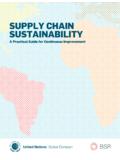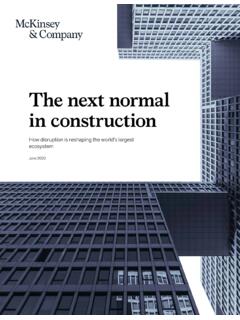Transcription of agricultural value chain development: threat or ...
1 DiD you know?National and international buyers of food products are becoming more concentrated: nearly 40% of the world s coffee is traded by 4 companies and 80% of Latin American banana exports are controlled by 3 The number and size of modern value chains, and thus jobs, will increase in developing countries with economic growth; already in more prosperous transforming and urbanized countries, the industries and services linked to agricultural value chains often account for over 30% of Modern agricultural value chains usually offer wage and self employment with better pay and working conditions than in traditional agriculture.
2 Although women constitute only 20-30% of agricultural wage workers worldwide (though more in some Latin American and African countries)3, they often predominate in high- value industries for export or domestic supermarkets, such as fresh fruits, vegetables, flowers, poultry and seafood (Table 1).4 In both traditional and modern agricultural value chains, women often face less favourable employment conditions than men: Women are commonly hired as temporary or casual workers (Table 1) while men predominate in permanent positions. In the Senegal tomato sector, for example, 2% of female workers and 28% of male workers have permanent Women are mainly hired for labour-intensive, relatively unskilled manual tasks, while men s jobs often involve operating machinery.
3 For example, in Kenya s fruit and vegetable export businesses, women constitute 80% of the workers in packing, labelling and bar-coding of Women workers usually receive lower wages than men although in some modern value chains their wages are similar to men s ( French bean and tomato industries in Senegal7 and Thailand s Sun Valley poultry company).4 Women predominate in unstable and flexible jobs that lack social security and other benefits, and are often the first to lose their jobs during economic anD rural employment policy Brief #4 2010agricultural value chain development : threat or opportunity for women s employment?
4 agricultural markets are rapidly globalizing, generating new consumption patterns and new production and distribution systems. value chains, often controlled by multinational or national firms and supermarkets, are capturing a growing share of the agri-food systems in developing regions. They can provide opportunities for quality employment for men and women, yet they can also be channels to transfer costs and risks to the weakest nodes, particularly women. They often perpetuate gender stereotypes that keep women in lower paid, casual work and do not necessarily lead to greater gender are the issues?
5 Modern agricultural value chains grow and become more sophisticated as countries industrialize and strengthen their position in global markets. Although such value chains are changing the gendered structure of employment and better educated women often compete fairly well with men for quality jobs, gender stereotypes that keep poor and uneducated women in lower paid, less skilled and more insecure work within the value chain still persist. The challenge is to ensure gender equality throughout the chain and to prevent traditional patterns of gender discrimination from being Gender inequalities in modern agricultural value chains In modern value chains, men are concentrated in higher status, more remunerative contract farming since they generally control household land and labour, while women predominate as wage labourers in agro-industries.
6 Women workers are generally segregated in certain nodes of the chain ( processing and packaging) that require relatively unskilled labour, reflecting cultural stereotypes on gender roles and abilities. Such gender-biased segregation is often used to legitimize the payment of lower wages to women even with exceptions for some non-traditional agricultural exports (NTAEs).5 Women s wages are 50% of men s wages in Pakistan in sugarcane production, but reach 80% of men s in the Mexican flower industry, and are similar to men s wages in modern horticulture supply chains (French beans or tomatoes) in Senegal.
7 Segregation and the casual or temporary nature of contracts limit women s opportunities to acquire new technical and entrepreneurial skills, increasing the risk of redundancy if their jobs are automated or if men are favoured in technical training. FAO/ R. FaiduttiLaws and regulations against gender dis- crimination and sexual harassment are often inadequate or not effectively en-forced. However, many multinational and national firms have a good record in ap-plying international labour standards and codes of conduct that improve working conditions and wages in workers, especially in the infor- mal sector, often do not belong to labour unions and thus have little opportunity to fight for their labour women farmers and entrepreneurs face higher entry barriers than men in modern value chainsWomen nearly always have less ac- cess than men to assets, credit, ser-vices, markets and information on new technologies.
8 Consumer preferences and export trade requirements. This reduces their chances of entering into contract farming differences in inputs are con- trolled for, there are no significant dif-ferences in male and female farmers producers, especially women, are often excluded from higher value domestic and export markets because they lack the transportation, cold stores, processing facilities, commu-nications and information. While coop-eratives and producer organizations are increasingly providing these services, relatively few women are members be-cause of costs or social men and women often have dif- ficulty in meeting the rigorous quality standards and deadlines of contractors, particularly for perishable products.
9 Women are further constrained by com-peting demands on their time. West Af-rican women growing perishable vege-tables often harvest late in the morning, after their domestic and child care work, with negative impacts on intra-household power rela- tions can undermine women s benefits from and incentives to engage in value chains if this involves providing unpaid labour in family farms managed by hus-bands or male relatives. Opportunities to grow their own crops for sale or work as wage labour in an agro-industry can improve their bargaining position so they can reduce this unpaid family work or secure a share of the countries with inadequate safety nets, social ser vice s or insurance, pov-erty and vulnerability to shocks (due to climate, family illnesses or death, or trade liberalization and market in-stability) discourage poor men from committing to high input agriculture in modern value chains.
10 Women tend to be even more risk averse, and subsis-tence agriculture, with small sales in the local market, often remains their only fall-back infrastructure weaknesses (roads, transport, water, electricity, sanitation) disproportionately increase the burden of women s unpaid domestic and car-ing tasks, reducing the time they can devote to paid work outside the women farmers and entrepreneurs in traditional value chainsAlthough men are increasingly mov- ing into food crops as returns to export crops fall, women often remain the main drivers of traditional value chains in local markets for fresh or processed foods such as vegetables, fruits, grains, tubers, dairy products and fish.















